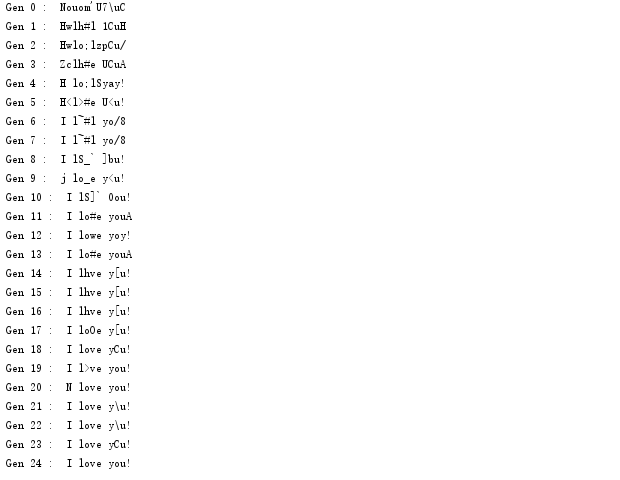GA--sentence match
来源:互联网 发布:qq农场辅助软件 编辑:程序博客网 时间:2024/06/05 10:20
Source of original code
Author: Morvan
Visualize Genetic Algorithm to match the target phrase.
Visit tutorial website for more: https://morvanzhou.github.io/tutorials/
The result

Absolutely, it’s satisfying.
With only 24 generations(Maybe a little more or less, randomly.), the sentence matches perfectly.
Algorithm & Code interpretation
the code component
The whole code is consists of three parts.
Some const variables , the class GA and the main function.
some const variables
TARGET_PHRASE = 'I love you!' # target DNAPOP_SIZE = 300 # population sizeCROSS_RATE = 0.4 # mating probability (DNA crossover)MUTATION_RATE = 0.01 # mutation probabilityN_GENERATIONS = 1000 # max generationDNA_SIZE = len(TARGET_PHRASE) # the size of DNA # target ASCII indices of the target string, convert string to numberTARGET_ASCII = np.fromstring(TARGET_PHRASE, dtype=np.uint8) ASCII_BOUND = [32, 126] # the bounds of the ASCII charactorsmain function
Firstly, we constuct a GA object ,named ga with the const variables above.
ga = GA(DNA_size=DNA_SIZE, DNA_bound=ASCII_BOUND, cross_rate=CROSS_RATE, mutation_rate=MUTATION_RATE, pop_size=POP_SIZE)Then, execute a for loop in the max generation
for generation in range(N_GENERATIONS): fitness = ga.get_fitness() # get the fitness of the current population best_DNA = ga.pop[np.argmax(fitness)] # best matching DNA best_phrase = ga.translateDNA(best_DNA) # translate the DNA to string we can read print('Gen', generation, ': ', best_phrase) # print the string if best_phrase == TARGET_PHRASE: # as if the string matches perfectly, break the loop break ga.evolve() # if not, evolve to the next generationGA class
function init()
def __init__(self, DNA_size, DNA_bound, cross_rate, mutation_rate, pop_size): self.DNA_size = DNA_size # the size of DNA DNA_bound[1] += 1 self.DNA_bound = DNA_bound # ASCII Bound self.cross_rate = cross_rate self.mutate_rate = mutation_rate self.pop_size = pop_size # population # define the population of first generation self.pop = np.random.randint(*DNA_bound, size=(pop_size, DNA_size)).astype(np.int8) # int8 for convert to ASCIITo initialize the class with const variables above
function translateDNA()
def translateDNA(self, DNA): # convert to readable string return DNA.tostring().decode('ascii')Such as translate
[126, 34, 45, 125, 46, 101, 32, 119, 38, 126, 33] to ‘~”-}.e w&~!’
function get_fitness()
def get_fitness(self): # count how many character matches match_count = (self.pop == TARGET_ASCII).sum(axis=1) return match_countTo calculate the fitness of every DNA in current generation.
List of array convert to list of int , int means match numbers
function select()
def select(self): fitness = self.get_fitness() + 1e-4 # add a small amount to avoid all zero fitness idx = np.random.choice(np.arange(self.pop_size), size=self.pop_size, replace=True, p=fitness/fitness.sum()) return self.pop[idx]To select better fit DNA
Every new array element depends on the probabilities of old array elements
(probability = element.fitness/fitness.sum())
The probability is higher, the more it will appear in the new array
function crossover()
def crossover(self, parent, pop): if np.random.rand() < self.cross_rate: i_ = np.random.randint(0, self.pop_size, size=1) # select another individual from pop cross_points = np.random.randint(0, 2, self.DNA_size).astype(np.bool) # choose crossover points parent[cross_points] = pop[i_, cross_points] # mating and produce one child return parentTo cross this parent with another random parent in current generation
function mutate()
def mutate(self, child): for point in range(self.DNA_size): if np.random.rand() < self.mutate_rate: child[point] = np.random.randint(*self.DNA_bound) # choose a random ASCII index return childTraverse all the elements in a DNA
Randomly convert a element to a random ASCII charactor index
function evolve()
def evolve(self): pop = self.select() pop_copy = pop.copy() for parent in pop: # for every parent child = self.crossover(parent, pop_copy) child = self.mutate(child) parent[:] = child self.pop = popTo evolve into the next generation.
Firstly, select the better fitting ones
Then, creat a copy of current generation
Then, traverse everyone in current generation,
cross it with another random one in current generation
mutate randomly.
Finally, upgrade to the next generation
Complete code
import numpy as npTARGET_PHRASE = 'I love you!' # target DNAPOP_SIZE = 300 # population sizeCROSS_RATE = 0.4 # mating probability (DNA crossover)MUTATION_RATE = 0.01 # mutation probabilityN_GENERATIONS = 1000DNA_SIZE = len(TARGET_PHRASE)TARGET_ASCII = np.fromstring(TARGET_PHRASE, dtype=np.uint8) # convert string to numberASCII_BOUND = [32, 126]class GA(object): def __init__(self, DNA_size, DNA_bound, cross_rate, mutation_rate, pop_size): self.DNA_size = DNA_size DNA_bound[1] += 1 self.DNA_bound = DNA_bound self.cross_rate = cross_rate self.mutate_rate = mutation_rate self.pop_size = pop_size self.pop = np.random.randint(*DNA_bound, size=(pop_size, DNA_size)).astype(np.int8) # int8 for convert to ASCII def translateDNA(self, DNA): # convert to readable string return DNA.tostring().decode('ascii') def get_fitness(self): # count how many character matches match_count = (self.pop == TARGET_ASCII).sum(axis=1) return match_count def select(self): fitness = self.get_fitness() + 1e-4 # add a small amount to avoid all zero fitness idx = np.random.choice(np.arange(self.pop_size), size=self.pop_size, replace=True, p=fitness/fitness.sum()) return self.pop[idx] def crossover(self, parent, pop): if np.random.rand() < self.cross_rate: i_ = np.random.randint(0, self.pop_size, size=1) # select another individual from pop cross_points = np.random.randint(0, 2, self.DNA_size).astype(np.bool) # choose crossover points parent[cross_points] = pop[i_, cross_points] # mating and produce one child return parent def mutate(self, child): for point in range(self.DNA_size): if np.random.rand() < self.mutate_rate: child[point] = np.random.randint(*self.DNA_bound) # choose a random ASCII index return child def evolve(self): pop = self.select() pop_copy = pop.copy() for parent in pop: # for every parent child = self.crossover(parent, pop_copy) child = self.mutate(child) parent[:] = child self.pop = popif __name__ == '__main__': ga = GA(DNA_size=DNA_SIZE, DNA_bound=ASCII_BOUND, cross_rate=CROSS_RATE, mutation_rate=MUTATION_RATE, pop_size=POP_SIZE) for generation in range(N_GENERATIONS): fitness = ga.get_fitness() best_DNA = ga.pop[np.argmax(fitness)] best_phrase = ga.translateDNA(best_DNA) print('Gen', generation, ': ', best_phrase) if best_phrase == TARGET_PHRASE: break ga.evolve()- GA--sentence match
- sentence
- Sentence
- ga
- ga
- GA
- GA
- match
- match
- match
- $match
- SQL sentence!
- everyday sentence
- userful sentence
- Daily Sentence
- switch sentence
- good sentence
- Good Sentence
- 欢迎使用CSDN-markdown编辑器
- RaspberryPi实验
- caffe学习系列2—步骤记录
- 基于树莓派的apache2服务器搭建
- 利用单例+观察者设计一个简易的分发/订阅消息机制
- GA--sentence match
- Ubuntu14.04安装搜狗输入法
- 欢迎使用CSDN-markdown编辑器
- Java内部类详解
- Redis
- MySQL中utf8和utf8mb4的区别
- phpstrom下断点调试代码
- extern的用法
- ubuntu: kdevelop 未指定有效的可执行文件!


